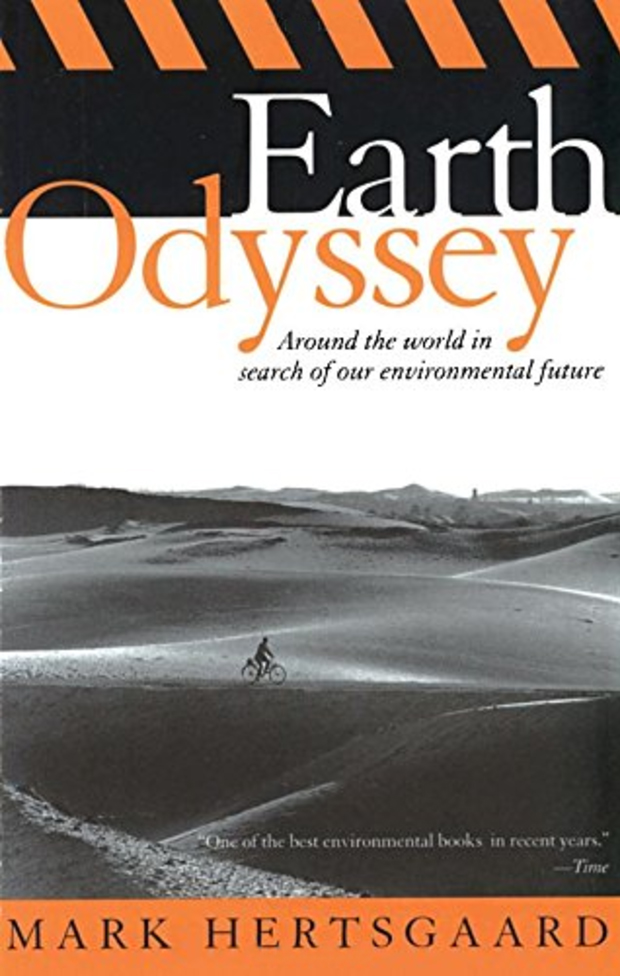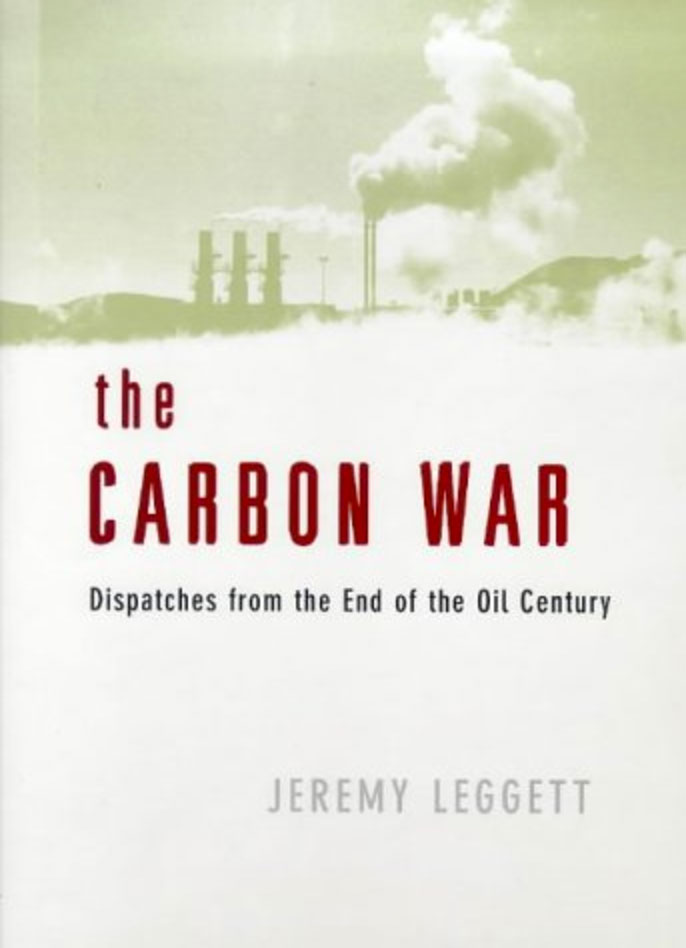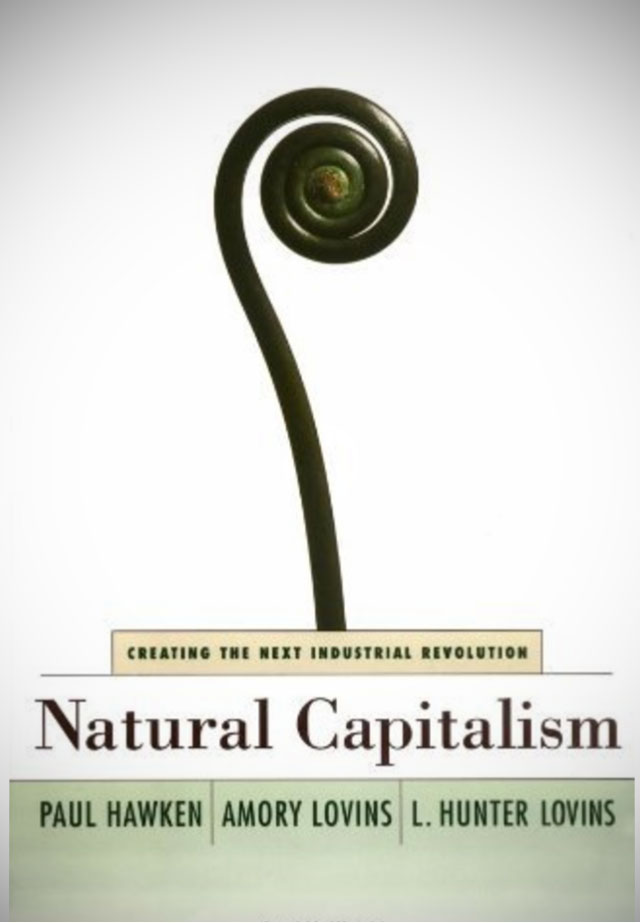Emerging From the Mire
Earth Odyssey
Mark Hertsgaard. 1999. Abacus, London. 372 pages.
The Carbon War: Dispatches From the End of the Oil Century
Jeremy Leggett. 1999. Allen Lanet, London. 338 pages.
Natural Capitalism: The Next Industrial Revolution
Paul Hawken, Amory B. Lovins and L. Hunter Lovins. 1999. Earthscan Publications Ltd., London. 396 pages.
A number of notable books addressing pollution and the prognosis for our planet were published last year.
In Earth Odyssey, author and journalist Mark Hertsgaard takes us on a journey to some of the most polluted areas in the world. His aim is “to describe our collective behavior and ask where such behavior is likely to lead.” He asks the big question: Will we survive? Hertsgaard teaches nonfiction writing at Johns Hopkins University and has written books on such varied subjects as the Beatles, nuclear energy, and press coverage of the Ronald Reagan presidency.
The Carbon War takes us on a journey of similar duration: the eight-year fight of scientists, environmentalists and their allies to keep the hope of an international pollution limitation agreement alive. Author Jeremy Leggett, who earned a doctorate in earth sciences at Oxford in 1978, was a member of the faculty at Imperial College of Science and Technology for 11 years. He was also a consultant for the oil industry, but his increasing concern about the environment (and especially global warming) drove him to leave academia and industry to join the international environment group Greenpeace. In this book, Leggett relates his experiences and subsequent qualified hopes for the future, leading him to pose the same question as Hertsgaard asked regarding our ultimate survival.
Natural Capitalism is an optimistic book. Its authors believe there must be a new industrial revolution in which the earth and its resources are treated with respect as the most valuable and irreplaceable capital of all: natural capital. Paul Hawken has been honored internationally for his environmental leadership, while Amory and Hunter Lovins are similarly recognized for their pioneering technical, economic and policy work. Between them, they have worked with an enviable roll call of international companies and organizations.
Survival: The Big Question
We begin our review with Hertsgaard’s big question: Will the human species survive? He endeavored to find out firsthand, and his quest, which spanned several years, took him to 19 countries around the world.
Pollution, he observed, runs through the whole gamut of societies and human conditions—from the most destitute need to the most predatory greed. He quickly assessed a fundamental dilemma, one in which the names and places might change, but the essential problem did not. Knowing, for example, that the trees in the Brazilian rain forest are essential to help absorb the carbon dioxide that our energy-guzzling industries and ever present cars are pumping into the atmosphere, how do you persuade a poor peasant family not to clear yet more trees to eke out a subsistence survival?
Earth Odyssey records that at every stratum within human societies, reasons and excuses are given as to why almost nobody is getting to grips with ecological deterioration—just yet. The same caveats were rehearsed to him everywhere: Before dealing with tomorrow’s environment we must have food for today.
As our other two books deal predominantly with Western attitudes to pollution, we narrow our focus on Earth Odyssey to Hertsgaard’s visits to China and Russia.
Earth Odyssey records that at every stratum within human societies, reasons and excuses are given as to why almost nobody is getting to grips with ecological deterioration—just yet.
The Burgeoning, Languishing East
China, currently earth’s number-seven industrial nation and destined, Hertsgaard believes, to be number one by around 2010, has seen the doubling of personal incomes since the market reforms of 1979—with a devastating effect on the environment. Among the urban population, ownership of household electronic goods has multiplied; for example, refrigerators from 7 percent to 62 percent and color TVs from 17 percent to 86 percent. China's burgeoning population is typical of developing nations everywhere, and they have “smelled the coffee.” They have experienced what so many in the prosperous industrialized world have long enjoyed—and they badly want more of it.
Most of China’s infrastructure and soaring industrial and economic growth is fueled by coal, one of its few abundant natural resources. For the foreseeable future, 30 to 60 new power plants are planned per annum to keep pace with projected demand, and three quarters of them will be coal fired.
Coal produces approximately 25 percent more carbon dioxide per unit of energy consumed than petroleum does, and twice as much as natural gas. China already has five of the world’s 10 most polluted cities, and acid rain causes an estimated $5 billion damage annually—in addition to the substantial damage it causes when it is “exported” to neighbors like South Korea and Japan. Yet Hertsgaard estimates that China’s projected growth of carbon dioxide emissions up to 2025 will—by itself—increase global greenhouse gas emissions by 17 percent.
In spite of China’s soot-laden air and polluted food and water—and the high rates of pollution-related diseases—Hertsgaard found most Chinese to be stoically unconcerned. “I’m used to it” was a typical response to his questions about health effects. The Chinese cite a favorite expression to brush aside concerns: “Is your stomach too full?”
In the meantime, radiation pollution and the poisoning of the soil and the water supply are near the top of Hertsgaard’s concerns about Russia. Fifteen nuclear reactors still operating in the former USSR are thought to be just as dangerous as the reactor that caused the Chernobyl explosion in 1986. Before that, there were three unreported nuclear disasters at Mayak, Russia—the most radiation-polluted place on earth. Hertsgaard labels it the site of the biggest nuclear catastrophe after Hiroshima and Nagasaki. Until 1956, nuclear waste was poured directly into the nearby Techa River. Nuclear dump explosions created the other two disasters. Radiation sickness, leukemia and congenital deformities—along with high incidences of other degenerative complaints—are commonplace in the area. Yet until recently, because this was a secret military area, the medical profession kept the people in the dark about their illnesses.
And while populations in cities such as Leningrad drink dangerous water tasting of heavy metal, one or another chemical-saturated river in Russia will burst into flames each month.
Grim Statistics
The Carbon War focuses on the ominous dangers of carbon pollution and associated global warming. Atmospheric concentrations of carbon dioxide, Leggett says, are 50 percent greater than before the Industrial Revolution. The 2,500 scientists and experts commissioned in 1988 to serve on the UN Intergovernmental Panel on Climate Change (IPCC) estimated that just to stabilize concentrations at this level would require a cut in global emissions of 50 to 70 percent—and they were not sure that even this drastic action would deter major climatic changes.
Global warming, Leggett informs us, threatens nasty things. U.K. Meteorological Office and NASA reports indicate that it could mean a decline of 10 to 15 percent in grain yields in Africa, tropical Latin America, and much of India and Southeast Asia, spelling famine for a similar percentage of people. Malaria and other tropical diseases are predicted to spread to millions more people.
The Carbon War cites a string of statistics. The 14 hottest years in 138 years of records (up to 1998) all occurred since 1980, and the global average temperature is 0.7 degrees Celsius (1.3 degrees Fahrenheit) hotter than 100 years ago. A comprehensive Dutch study of 1996 states that, in the short term, the world’s emissions must get on track and not exceed a 2-degree Celsius (3.6-degree Fahrenheit) rise. Beyond that, it warns, the risk to the climate and to life itself would be too hazardous. This would require industrial countries cutting emissions by 19 to 46 percent from 1990 levels by 2010.
In addition, a 1998 computer model by the U.K. Meteorological Office indicates that without deep emissions reductions, many tropical forests will die in the second half of the 21st century—leading, it says, to runaway global warming.
As Leggett, fellow scientists, Greenpeace and other environmentalists delivered their urgent wake-up call to governments, industry and the public, they became ever more convinced that greenhouse gases were turning up global temperatures. But they discovered that immensely powerful and unscrupulous vested interests were arrayed against them. And time, according to Leggett’s prognosis, is running out for the delicately balanced world climate. The Carbon War is a personal diary of the eight-year-long nail-biting, behind-the-scenes battle to make the case for urgent reductions in the emission of greenhouse gases.
The book follows a slow and painful battle against determined opposition as Leggett tracks increasingly worrying findings on global warming, such as the 1990 declaration by the IPCC scientific working group that they were “certain” that global warming was a future reality—unless greenhouse-gas emissions were reduced.
Yet at every step, and with a voice that seemed to be whispering in the ear of every influential person, was the ubiquitous Global Climate Coalition. The GCC, representing 55 companies and trade associations (including the immensely powerful oil and automotive sectors), attempted to reverse, reinterpret or water down resolutions and reports that cut across the interests of its members—the “carbon club,” as environmentalists dubbed them.
Kyoto Cliffhanger
Leggett records that the 10-day Kyoto Conference, held in Japan in late 1997, was a defining moment for environmentalists and industry in the war to control greenhouse gases and global warming. The delegates were out in force: 1,500 from government; 3,600 observers from business, environmental and intergovernmental agencies; and 3,500 journalists. Any meaningful agreement, and with it the hopes of environmentalists like Leggett, hung on a thread.
The approach agreed to in New York in 1992 and further developed at the Berlin Climate Summit of 1995 was that the 20 percent of the world population that is responsible for 80 percent of carbon gases—namely the industrialized nations, headed by the United States—must lead the way in curtailing greenhouse emissions.
Having successfully lobbied the U.S. Congress, however, the “carbon club” seemed to be within an ace of winning, thereby knocking emission limitations and reductions in the more prosperous, industrial nations right off the rails, probably for years.
Seemingly against all hope, the pivotal U.S. negotiating team moved into line with other advanced industrial nations and dropped insistence, almost literally at the last hour, of immediate participation in emission reductions by developing nations—thus removing the final obstacle to an agreement.
Leggett movingly describes the overwhelming relief after the marathon final negotiating session. “The applause was long and loud. On the platform, staid UN officials embraced. On the negotiating floor, I later learned, seasoned diplomats were weeping” (Carbon War, p. 321).
And so, with the adoption of the Kyoto Protocol, our delicately balanced planet was given a slender ray of hope in environmentalists’ eyes. But, they wonder, will the world unhitch itself from carbon fuels in time to avoid catastrophic and irreversible disaster? Leggett ends his book quizzically: “The solar [energy] revolution is coming. It is now inevitable. The only question left unanswered is, will it come in time?” (p. 328).
Perhaps our third book, Natural Capitalism, will enlighten us.
Pricing Out Pollution
Natural Capitalism’s central tenet is that unless the true cost of the earth’s resources is recognized and we begin to factor the cost in to our use and abuse of those resources, we will continue to fool ourselves that we’re getting away with polluting our planet—until it's too late.
The book describes how ludicrous the measures of the capitalist system really are. It gives awesome figures of waste and lost wealth in the United States alone: Of $9 trillion spent annually, $2 trillion, they estimate, is wasted. They define waste as something out of which the buyer derives no value, perhaps even reaping an unwanted effect. Hawken and the Lovinses give a long list of examples, together with some associated costs. These include traffic jams, highway accidents, health-care costs, property damage, lost tax revenue, ill health due to pollution (cancer, for instance), and the avoidable cost of imported oil.
According to Natural Capitalism, nearly one million pounds of material is wasted by or on behalf of each U.S. resident per annum.
According to Natural Capitalism, nearly one million pounds of material is wasted by or on behalf of each U.S. resident per annum. This includes such varied items as wasted food, hazardous waste, polystyrene and construction debris. And then there is each person’s share of the 3.3 trillion tons of carbon in carbon dioxide emissions.
Hawken and the Lovinses estimate that it would take the resources of two more Earths to bring the current world population up to U.S. and Canadian standards of living; three more to allow for a doubling of population; and 12 more if standards of living double during the next 40 years.
And the rest of the world is playing catch-up with ever accelerating speed. Both Earth Odyssey and Natural Capitalism attest to this trend. It took a century for British incomes to double in the Industrial Revolution. In the United States, it took only 50 years after industrialization. It took Korea 25 years. China recently took nine years to achieve the same thing.
The Environmental Factor
“Humankind has inherited a 3.8-billion-year store of natural capital. At present rates of use and degradation, there will be little left by the end of the [21st] century” (Natural Capitalism, p. 3). The authors’ concept of natural capitalism seeks to persuade the throwaway society to place a real value, financial and moral, on finite resources. These include the environmental treasures of soil, air, water and minerals, as well as flora and fauna.
A central tenet is that no price can be placed on the services we receive from living systems that have no known substitute, such as oxygen from living plants. Nonetheless, some estimates value what the earth supplies to us at around $36 trillion per annum—near the annual gross world product of $39 trillion.
The book introduces four central strategies on the basis that a move away from conventional capitalism requires a new way of thinking.
First, radical resource productivity is the cornerstone of the concept of natural capitalism. By slowing resource depletion (using less) at one end of the chain, and by drastically lowering pollution at the other, a third benefit emerges—that of meaningful employment./p>
Second is the revolutionary yet logical concept of biomimicry. If a spider can produce silk as strong as Kevlar—but much tougher—by ingesting flies and crickets, and diatoms can make glass using seawater, why, ask the authors, do we need boiling sulfuric acid and high-temperature extruders? They estimate that, in the U.S. economy, only 6 percent of the vast flow of materials ends up as actual products—profligate waste by any standard.
Third, Hawken and the Lovinses propose a service and flow economy. This entails a radical shift from goods and purchases to what they call “service and flow.” If service and utility rather than acquisition become the measure of contentment, well-being will perchance override crude ownership.
Fourth, the concept of investing in natural capital acknowledges that worldwide depletion of natural capital should be reversed. Instead of exploiting the earth, we should be feeding back to it in what the authors call a “virtuous cycle.”
“Economics cannot function as a reliable guide until natural capital is placed on the balance sheets of companies, countries and the world. As it stands, the capitalist system is based on accounting principles that would bankrupt any company” (p. 61). Economic theory must be transformed, the authors argue, so that the value of human and natural capital is included in the analysis.
Natural Capitalism is bullish in its prognosis. It endeavors to provide a believable alternative to the destructive wastefulness of industry. Unexpectedly large improvements can be gained from resource productivity (better design; using fewer materials; eliminating waste and pollution). Environmental responsibility is not at odds with core business values; rather, the awesome inefficiencies of waste disposal and pollution are almost always more costly than the steps that would eliminate them.
“Meta-industrial engineers are creating ‘zero-emission’ industrial parks whose tenants will constitute an industrial ecosystem in which one company will feed upon the nontoxic and useful wastes of another. Architects and builders are creating structures that process their own wastewater, capture light, create energy, and provide habitat for wildlife and wealth for the community, all the while improving worker productivity, morale, and health” (p. 16).
Looking to a Fourth Book
Earth Odyssey and The Carbon War are both readable, entertaining, yet disturbing books, setting out in different ways the urgency with which humanity must get deadly serious about cleaning up its environmental act.
Hertsgaard opines that the time lag between cause and effect is a rope with which we seem collectively determined to hang ourselves. In the meantime, Leggett’s The Carbon War tells us that climate change, ozone depletion and population growth could now be perilously close to being unstoppable and irreversible. Even if ozone-layer depletion ended now, some fear that it would be unlikely to recover for decades.
Natural Capitalism is a more optimistic and visionary work, illustrating that there are viable alternatives to the intolerable burdens we are placing on ourselves and our planet. But will the transformations in thinking and in economic and industrial practice be made quickly enough and by enough key people to make the difference?
Whatever solutions these three books put forward, however, the future transformation that another book, the Bible, pictures, will be the most necessary and far-reaching of all: a change in human hearts and minds.
With this prophesied transformation is a promise that there will also be an ecological renewal and restoration. “I will give you a new heart and put a new spirit within you; I will take the heart of stone out of your flesh and give you a heart of flesh. I will put My Spirit within you and cause you to walk in My statutes, and you will keep My judgments and do them. . . . So they will say, ‘This land that was desolate has become like the garden of Eden; and the wasted, desolate, and ruined cities are now fortified and inhabited.’ Then the nations which are left all around you shall know that I, the Lord, have rebuilt the ruined places and planted what was desolate. I, the LORD, have spoken it, and I will do it” (Ezekiel 36:26, 27, 35, 36).
It has been said that problems cannot be solved within the mindset that created them. If that is so, then what this world desperately needs is a different mindset. And that is exactly what God proposes to provide.
Vision endeavors to show that we can, on a personal level, experience the benefits of such a mindset now.




